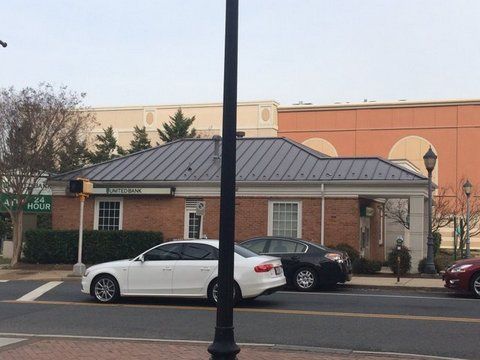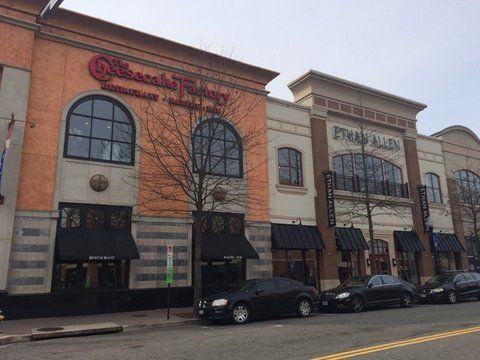After decades of plunging population figures, the Washington DC city limits are once again booming. Cranes slice through the sky at numerous locations, broadly visible when crossing the expansive Potomac River. Equally visible are the numerous edifices on the Potomac’s southern banks, in Arlington County, Virginia. Its powerful skyline famously surpasses that of Washington, DC, since the national capital’s stringent height limitations prevent the construction of anything more than mid-rises. Lacking those restrictions, Arlington absorbed much of the demand for high-rise office space in the region by the middle of the 20th century, particularly noticeable in the Rosslyn district in the hyperlinked image above. These days, Rosslyn might not boast so many construction cranes, but that’s only because its business district is quite mature by this point.
Continuing further into Arlington County, a mile to the west offers a similar scenario.

Essentially we encounter another downtown, this one generally referred to as Clarendon, largely after the Clarendon metro stop that forms its centerpiece. But most of the construction doesn’t look all that old, and it isn’t. As the land around the Rosslyn metro stop began to achieve relative build-out, demand surged at the next station on the line (called Courthouse), then the one after that (Clarendon). Authorities in Arlington County deliberately relaxed height and density limitations in zoning laws, to help meet this burgeoning demand for housing and office space near the Metro stops, resulting in some patently visible Transit Oriented Development (TOD). This practice continues at metro stops to the south and west, so that the skyline of Arlington County claims a ribbon of explosive density…far more than simply the “urban village” of Rosslyn, visible while crossing the Potomac. This Wikipedia photo for Arlington County effectively demonstrates the train of high-rises, which parallels the path of the DC subway and heavy-rail train system.
But most of these dense, consciously planned “urban villages” remain a work in progress. Returning to the land near the above photo, it’s clear that the Clarendon stop has not yet achieved full build-out. How do we know?

It’s a run-of-the-mill bank, like you’d see at pretty much any major arterial in America. It has multiple entrances and exits, about a dozen off-street spaces, a 24-hour outdoor ATM…you name it. Amazingly, it doesn’t seem to offer drive-through banking. But it’s got all the amenities you’d expect from a bank in the suburbs. And while, technically, Arlington is a suburb to Washington DC, its aspirations are clearly urban. Just look at the land surrounding this bank.


It’s an intense mix of offices, residences and retail, built all the way to the sidewalk, with a Floor-Area Ratio of 5.0 or greater. No visible off-street parking. And, on the opposite side of Clarendon Boulevard, it gets even more intense.

Kind of makes United Bank seem humble. It’s the last low-slung corner. Everything else within a five-minute walk of the Clarendon Metro Station has turned over to real estate investment interests, and a quick survey of this intersection through Google Street View, coupled with a sliding of the chronology bar, shows that at least two of the four corners underwent a transformation to a more intense use within the last eight or nine years.
The owners of this United Bank property are sitting on a gold mine, and they know it. Banks are typically stable industries with high profit margins. They make desirable tenants and are far less likely to close than, say, a nightclub. But, since land values around the Clarendon metro stop are only likely to increase—and we’re a block away right here—how much longer can the owners justify such a low-intensity use? Smart speculators will sell right before a recession, so that the new owner can raze the bank, tear up the parking lot, then build anew at six or more stories, featuring an office or apartment building, underground parking, and restaurants on the first floor. It’s obvious this is what happened to the land immediately adjacent to Union Bank; here’s the back of the adjacent use.


And here’s the front:


Pretty fancy stuff.
At this point in time, local planners relegated the highest-intensity uses to Clarendon Boulevard itself, which for the most part is one-way eastbound and forms the proximal path of the Orange Line underneath. Its counterpart road, the westbound Wilson Boulevard just a block to the north, is visibly less intense.


For the time being, this stretch of Wilson has the character that I suspect was typical of Clarendon Boulevard twenty years ago—that is, the much lower intensity look and feel of the Union Bank. Whether it retains this look remains to be seen; without scrutinizing Arlington’s zoning ordinance, I’d suspect that planners preserved the lower intensity character visible here, out of the interest of the single-family detached dwellings that dominate the scene just a few hundred feet to the north, which looks like this. Even in urban settings like Clarendon, owners of detached homes generally remain averse to skyscrapers right next door.
Arlington is a political oddity in almost every sense of the word. It’s a freestanding county originally intended to serve the portion of the District of Columbia southwest of the Potomac (the “Virginia side”), when initial plans for the national capital intended to carve out a perfect quadrilateral of 100 square miles, bisected by the river. Virtually all development took place on the northern side (ceded by Maryland), and the 1847 retrocession returned the 31 square miles to Virginia. It became Arlington County, the smallest self-governing county in the country, and, thanks to steady growth, one of the most densely populated. With the exception of some of the counties abutting New York City, Arlington may be the most consistently urban suburban area in the country. It wouldn’t have had such a skyline if it were a suburb to, say, Cincinnati. In fact, those village centers would feature a lot more architecture like Union Bank.
No, Arlington got where it is thanks the metro’s intense growth of high-skilled workers, the stringent regulations on the DC side, a robust metro system, and—most importantly—the human will to locate in high-density settings, atypical of most of American suburbia. The will to live in big multifamily developments goes hand-in-hand with the region’s economic prosperity: land costs are so high that many professionals have no choice, just as developers have no choice but to build up. Within five years, another mammoth mixed-use building will most likely replace Union Bank. While this won’t be great for people who bank at Union and love easy parking, chances are they’ll open another branch nearby…within walking distance of a metro stop.
A longer version of this article originally appeared in the author’s personal blog, American Dirt. All photos taken by the author.
